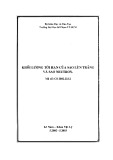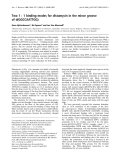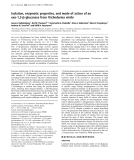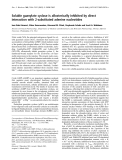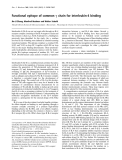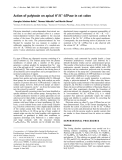
BioMed Central
Page 1 of 16
(page number not for citation purposes)
Virology Journal
Open Access
Research
Conserved positive selection signals in gp41 across multiple
subtypes and difference in selection signals detectable in gp41
sequences sampled during acute and chronic HIV-1 subtype C
infection
Gama P Bandawe*1, Darren P Martin1, Florette Treurnicht1, Koleka Mlisana2,
Salim S Abdool Karim2, Carolyn Williamson1 and The CAPRISA 002 Acute
Infection Study Team2
Address: 1Institute of Infectious Disease and Molecular Medicine, Faculty of Health Sciences, University of Cape Town, Anzio Road, Observatory,
7925, South Africa and 2Doris Duke Medical Research Institute, Nelson R Mandela School of Medicine, University of KwaZulu-Natal, Private Bag
X7, Congella, 4013, South Africa
Email: Gama P Bandawe* - gama.bandawe@uct.ac.za; Darren P Martin - darrin.martin@uct.ac.za;
Florette Treurnicht - florette.treurnicht@uct.ac.za; Koleka Mlisana - mlisanak@ukzn.ac.za; Salim S Abdool Karim - karims1@ukzn.ac.za;
Carolyn Williamson - carolyn.williamson@uct.ac.za; The CAPRISA 002 Acute Infection Study Team - caprisa@ukzn.ac.za
* Corresponding author
Abstract
Background: The high diversity of HIV variants driving the global AIDS epidemic has caused many
to doubt whether an effective vaccine against the virus is possible. However, by identifying the
selective forces that are driving the ongoing diversification of HIV and characterising their genetic
consequences, it may be possible to design vaccines that pre-empt some of the virus' more
common evasion tactics. One component of such vaccines might be the envelope protein, gp41.
Besides being targeted by both the humoral and cellular arms of the immune system this protein
mediates fusion between viral and target cell membranes and is likely to be a primary determinant
of HIV transmissibility.
Results: Using recombination aware analysis tools we compared site specific signals of selection
in gp41 sequences from different HIV-1 M subtypes and circulating recombinant forms and
identified twelve sites evolving under positive selection across multiple major HIV-1 lineages. To
identify evidence of selection operating during transmission our analysis included two matched
datasets sampled from patients with acute or chronic subtype C infections. We identified six gp41
sites apparently evolving under different selection pressures during acute and chronic HIV-1
infections. These sites mostly fell within functional gp41 domains, with one site located within the
epitope recognised by the broadly neutralizing antibody, 4E10.
Conclusion: Whereas these six sites are potentially determinants of fitness and are therefore
good candidate targets for subtype-C specific vaccines, the twelve sites evolving under diversifying
selection across multiple subtypes might make good candidate targets for broadly protective
vaccines.
Published: 24 November 2008
Virology Journal 2008, 5:141 doi:10.1186/1743-422X-5-141
Received: 29 September 2008
Accepted: 24 November 2008
This article is available from: http://www.virologyj.com/content/5/1/141
© 2008 Bandawe et al; licensee BioMed Central Ltd.
This is an Open Access article distributed under the terms of the Creative Commons Attribution License (http://creativecommons.org/licenses/by/2.0),
which permits unrestricted use, distribution, and reproduction in any medium, provided the original work is properly cited.

Virology Journal 2008, 5:141 http://www.virologyj.com/content/5/1/141
Page 2 of 16
(page number not for citation purposes)
Background
Detailed characterisation of the selective forces that are
shaping HIV-1 evolution is crucial if we are to fundamen-
tally understand HIV pathogenesis. To design vaccines
that will protect against HIV, we might ultimately require
accurate predictive models of how particular viral proteins
will evolve in response to particular selection pressures.
To avoid host immune responses, the virus' survival strat-
egy is dominated by high mutation and recombination
rates that, while possibly jeopardizing its long term sur-
vival as a species, guarantees its short term success [1].
This selection for continual change, called positive (or
diversifying) selection, is driving HIV evolution against a
background of negative (or purifying) selection favouring
preservation of functionally important protein sequences
[2]. Thus, HIV evolution is characterised by a perpetual
tug-of-war between the immediate short term benefits of
positively selected immune escape mutations, and the
long term selective advantages of maintaining optimal
protein function [3,4].
These conflicting forces are perhaps most manifest within
the env gene that encodes the HIV envelope proteins. The
HIV envelope is made up of two components: gp120 and
gp41. These two proteins are targeted by both the
humoral and cellular arms of the immune system.
Whereas positive selection that is detectable in parts of env
encoding the exposed surfaces of gp120 is most likely
driven by the need for the virus to escape either neutraliz-
ing antibodies [5,6] or cytotoxic T lymphocytes, positive
selection at sites encoding unexposed residues is presum-
ably driven by selection for both escape from cytotoxic T
lymphocytes and altered cell tropism [7-13]. Although
certain regions of env are particularly accommodating of
positive selection, most codons are functionally impor-
tant and as a consequence many residues are detectably
evolving under negative selection [14].
Both gp120 and gp41 have functionally distinct but addi-
tive roles in HIV infection and pathogenesis [15]. While
gp120 mediates entry via CD4 and co-receptor binding,
gp41 is essential for post receptor binding events includ-
ing viral fusion and assembly [16-20]. Despite these gp41
mediated processes being amongst the most significant
determinants of replicative capacity and pathogenic
potential in any given strain [21] there has been much
more research focused on the selective forces acting on its
partner, gp120.
Recently emphasis has been placed on the study of viruses
sampled close to transmission (during acute and early
infection) based largely on the premise that protection
against these variants must be the primary target of vac-
cine and microbicide development strategies. HIV is
believed to experience extremely severe population bottle-
necks during transmission with usually only one, or at
most a few, genetic variants establishing an infection
within a new host [14,22,23]. As a large proportion of
transmissions are thought to occur during the acute phase
of infection [24], evolutionary innovations arising early
on in infections may also be disproportionately impor-
tant for the long-term evolution of HIV in that many selec-
tively advantageous mutations occurring later in
infections have a greater chance of "missing the boat" for
transmission [25]. The viruses that make it through the
transmission bottleneck may contain a lot of immune
evasion mutations that are irrelevant or possibly even evo-
lutionarily harmful within the context of their new host's
immune environment. It would be expected that many of
these formerly useful mutations – especially those with
associated replicative fitness costs – would be strongly
selected against [26-28]. While the evolutionary relevance
of "transmission fitness" and the "transmission sieve" in
HIV [29,30] are currently under debate (see Lemey et al
[31] for a review), it is widely acknowledged that the
reversion of immune escape mutations that incur replica-
tive fitness costs is a prominent feature of HIV evolution
[27,32,33].
Given that (i) transmission may selectively favour geno-
types with high transmission fitness, (ii) recently trans-
mitted viruses will have, on average, spent a greater
proportion of their evolutionary histories in acute infec-
tions than viruses sampled during chronic infections and
(iii) transmitted viruses generally enter an environment
selectively favouring the rapid reversion of some former
immune evasion mutations, we anticipated that the genes
of recently transmitted viruses might display marks of
selection that differentiated them from viruses sampled
during chronic infections.
We show here that whereas signals of selection in gp41 are
largely conserved between both different HIV subtypes
and viruses sampled during different stages of HIV infec-
tions, at least six sites in gp41 display signals of selection
that appear to differentiate viruses sampled during acute
and chronic infections.
Results
Recombination in gp41
As recombination occurs at high frequencies during HIV
infections [34-36] and can seriously confound inferences
of positive selection [37-39] it was necessary to account
for the positions of recombination breakpoints in nine
gp41 datasets drawn from different subtypes and circulat-
ing recombinant forms. The presence of potential recom-
bination breakpoints in these datasets was first
determined using the GARD method [40]. The distribu-
tion of detected breakpoints was apparently non-random

Virology Journal 2008, 5:141 http://www.virologyj.com/content/5/1/141
Page 3 of 16
(page number not for citation purposes)
with three breakpoint clusters identified (Figure 1): one in
the loop region; the second around the major trans-mem-
brane domain; and the third in the region downstream of
the Kennedy sequence into the LLP2 domain. Analysis
using alternative recombination analysis methods imple-
mented in the program RDP3 [41] confirmed that break-
points clustering around the transmembrane domain
constituted evidence of a statistically significant (global P
< 0.01) recombination hotspot (Additional file 1). This
result supports a recent claim that gp41 is the site of a
major "inter-subtype" recombination hotspot in HIV-1M
genomes [42]. In fact the breakpoint hotspot detected in
the part of gp41 encoding the transmembrane domain
maps to almost precisely the location identified by Fan et
al [43].
None of the three areas of gp41 where breakpoint clusters
were observed contain predicted hairpins or other detect-
able RNA-secondary structures that might have mechanis-
tically predisposed these regions to recombination.
Besides being caused by biochemical predispositions to
recombination, recombination hotspots are also poten-
tially caused by purifying selection acting on defective
recombinants. By culling recombinants that are less viable
than parental viruses, purifying selection will yield
genomes with breakpoints clustered within genome
regions that tolerate recombination well [44]. As with
mutation events, it is probably most accurate to think of
there being a continuum of different kinds of recombina-
tion events: From those that are lethal through those that
are only mildly deleterious or neutral to those that are
advantageous. Since the least deleterious recombination
events tend to be those that exchange self-contained
sequence "modules" which continue to function properly
within the context of genomic backgrounds very different
from those in which they evolved [45-47], it is possible
that the recombination breakpoint clusters that are detect-
able in gp41 simply demarcate the main modules of this
protein.
Consistently detectable positive selection signals across
multiple subtypes
Recombination breakpoints detected by GARD were
taken into consideration during subsequent selection
analyses. In order to get a comprehensive picture of selec-
tive forces acting on gp41 during HIV infections in general
we examined the nine gp41 datasets using the SLAC, FEL
and IFEL methods implemented in Hyphy. Although
Distribution of recombination breakpoints across the gp41 encoding region of two subtype C datasets and seven other sub-types/circulating recombinant forms as detected by the GARD methodFigure 1
Distribution of recombination breakpoints across the gp41 encoding region of two subtype C datasets and seven other sub-
types/circulating recombinant forms as detected by the GARD method. The positions at which recombination breakpoints are
inferred to have occurred in the different datasets are illustrated using vertical coloured lines specific for each dataset.
FP NHR LOOP CHR
MPER
TM Ken LLP2
LLP3
LLP1
K
e
n
FP
NHR
L
OO
P
C
HR
MPER
LLP1
TM
LLP2
L
LP
3
external
membrane
internal

Virology Journal 2008, 5:141 http://www.virologyj.com/content/5/1/141
Page 4 of 16
(page number not for citation purposes)
selection signals detectable in multiple HIV subtypes have
already been described within gp41 [48,49], these signals
were detected without taking recombination into account.
Using the three recombination-aware selection analysis
methods in Hyphy we collectively detected a total of 346
positive selection signals across all 9 datasets (59 by SLAC,
159 by FEL and 128 by IFEL) at 89 different sites within
gp41. Purifying selection in gp41 is pervasive with 214 out
of its 352 sites detectably evolving under purifying selec-
tion in at least one of the nine datasets.
Examination of every site that is detectably evolving under
any form of selection in any of the datasets indicated var-
ying levels of selection acting on the various gp41
domains. Analysing the ratio of sites evolving under posi-
tive and purifying selection in different parts of gp41 indi-
cated that the LLP1 domain has the highest (0.578947)
followed by the MPER (0.545455) and the loop region
(0.461538). The fusion protein also has a high ratio of
sites evolving under positive selection (0.428571). The
trans-membrane domain (0.363636) and the C and N-
heptad repeats (0.242424 and 0.184211, respectively)
have the lowest ratios of positively:negatively selected
sites. The trans-membrane domain is conserved and
shares common characteristics with other viral and cellu-
lar membrane spanning domains [50-52] and is therefore
unlikely to tolerate high levels of immune evasion driven
positive selection. Similarly the N and C-heptad repeats
need to productively interact with one another within the
gp41 trimer [53] and the conserved residues in their
coiled coil and helical domains required for these interac-
tions [54] are understandably evolving under strong puri-
fying selection.
Seventeen gp41 sites were consistently detected to be
evolving under positive selection in two or more of the
nine analysed datasets (i.e. in at least two different sub-
types or CRFs; Table 1 and Figure 2). All of these sites
other than that at position 172 were also detectable evolv-
ing under positive selection by more of the three analysis
methods. Of these 17 sites, five were situated in the over-
lapping rev exon 2 reading frame and, due to the con-
founding effects of overlapping reading frames on the
inference of selection [55], these sites should probably be
discounted. Nevertheless, the twelve other identified sites
are presumably globally subject to the same selective pres-
sures and might therefore indicate good targets for
broadly effective treatment or vaccine interventions.
Studies by Choisy et al. [48] and Travers et al. [49] have
used multiple subtypes to respectively identify nine and
eight sites evolving under positive selection in gp41.
Whereas the Choisy et al., study focused on comparing the
locations and strengths of positive selection signals in dif-
ferent HIV-1 sequence alignments, that of Travers et al.,
focussed on likely selective pressures that have consist-
ently shaped the evolution of HIV-1 group M env
sequences since their diversification from the original
group M founder virus. Choisy et al used a set of four sub-
type-specific alignments in their analysis and Travers et al.,
used a single alignment of 40 sequences containing
viruses from multiple subtypes. Although both these stud-
Table 1: The positions of sites identified as under positive selection across multiple HIV-1M lineages.
Codon position (HXB2 gp41) Selection analysis method Detected elsewherea
SLAC FEL IFEL
24 B, D B, D T, C
54 B, F, CRF 02_AG CRF 01_AE
96 C, D C, A, D C, B, D, CRF 01_AE T
101 B, G B, G B, G
130 B C, A, B C, B T
137 A, B A, B, G B T
163 C, D, CRF 02_AG C C, D, CRF 02_AG C
165 D, G C, A, G
172 C, B, G, CRF 02 _AG
210 C, A, CRF 01_AE C, A, B, D, F, G C, D, CRF 01_AE
214bA A, B A, B
221 G, CRF 01_AE C, A, G, CRF 01_AE, CRF 02_AG C, D, G, CRF 01_AE
230 A, D A, G, CRF 01_AE
271 C, CRF 01_AE C, B, D
328 C, B, G C, B, G C, B, G
332 A, B, G A, B, G B, D, G, CRF 01_AE C
349 C, F, CRF 01_AE, CRF 02_AG CRF 02_AG C
a T = Travers et al (2005), C = Choisy et al (2003).
bHighlighted in yellow are sites that fall within the overlapping reading frame of the rev exon 2.

Virology Journal 2008, 5:141 http://www.virologyj.com/content/5/1/141
Page 5 of 16
(page number not for citation purposes)
ies used a set of maximum likelihood methods with six
models of codon substitution, neither took recombina-
tion into account. Despite, the different methodologies
and datasets used between our analysis and these two
other studies, seven of the twelve sites we have identified
as convincingly evolving under positive selection across
multiple subtypes were also identified in these other stud-
ies. Importantly, our list helps reconcile differences
between these other studies in that it includes six sites that
were identified in one but not the other of the studies.
This both confirms the robustness of the methodology we
have employed and adds credibility to the notion that the
five other sites we have identified have also probably been
evolving under positive selection since the origin of the
HIV-1 M subtypes.
The locations of both the 12 positively selected gp41 sites
falling outside the overlapping rev exon and the five
within the exon were examined in relation to probable
glycosylation sites (PNGs), the position on the envelope
spike, and the presence of CTL and nAb epitopes. Glyco-
sylation in gp41 appears to be required for stabilisation of
fusion active domains and efficient functioning [56]
rather than for immune escape. We accordingly found no
evidence of enrichment of positively selected codons asso-
ciated with PNGs. We also found no significant associa-
tion between the locations of CTL or nAb epitopes and
sites under positive selection. We obtained the same
results when all sites detected by two or more methods in
each subtype were considered.
Given that the majority of nAb sites are in the external
exposed domains of gp41, we analysed the sequences
encoding these regions separately from the rest of the
gene. In contrast with our previous result, within these
domains alone, of the 173 sites analysed, the nine sites
detected to be under positive selection in multiple data-
sets (Table 1) had a significant tendency to be located
within neutralizing and other antibody epitopes (p =
0.01356: chi squared). The LLP1 domain alone has 3 sites
Graphical representation of the sites under selection seen in table 1 on a consensus scheme of the gp41 domainsFigure 2
Graphical representation of the sites under selection seen in table 1 on a consensus scheme of the gp41 domains. Each detec-
tion method is shown in a different colour. Positively selected sites are at the top and negatively selected sites are on the bot-
tom. The height of the top bars is proportional to the number of subtypes in which the position is detected as evolving under
positive selection. On the underside only sites detectably under purifying selection in more than 3 datasets are represented.
The diamonds denote sites detected to be evolving under positive selection by Travers et al (2005), while stars denote sites
detected to be evolving under positive selection by Choisy et al (2003). The area overlapping the rev exon 2 is shaded in grey.
FP NHR LOOP CHR MPER TM Ken LLP2 LLP3 LLP1
K
FP
NHR
LOOP
C
HR
MPER
L
LP
1
TM
L
P
3
Ke
n
L
LP2
LL
external
membrane
internal


